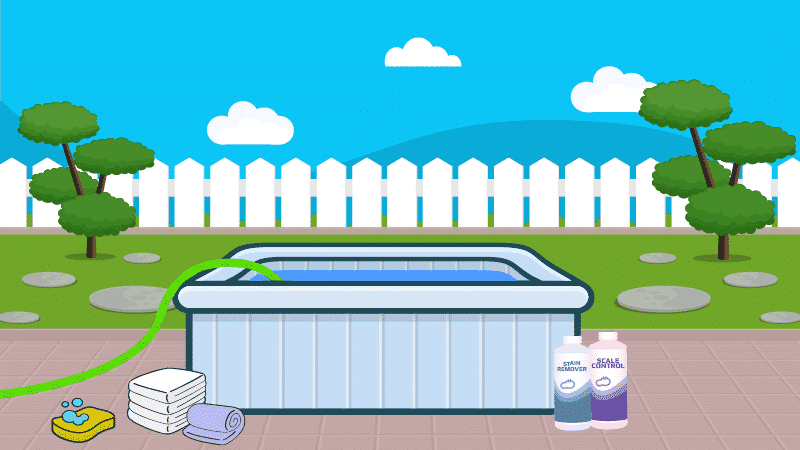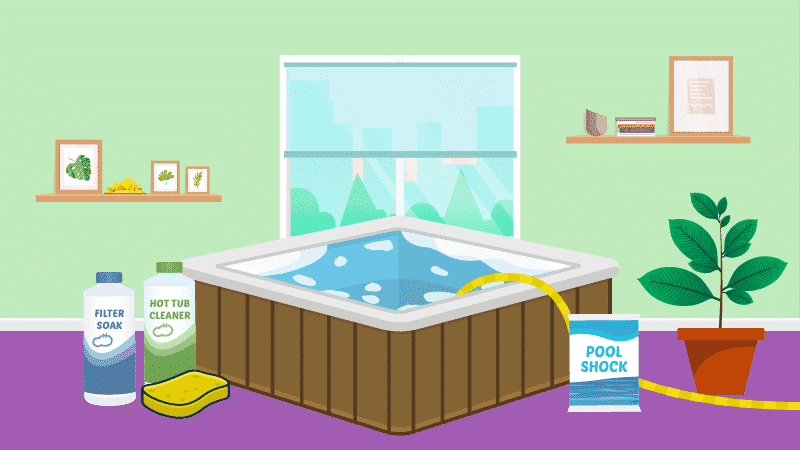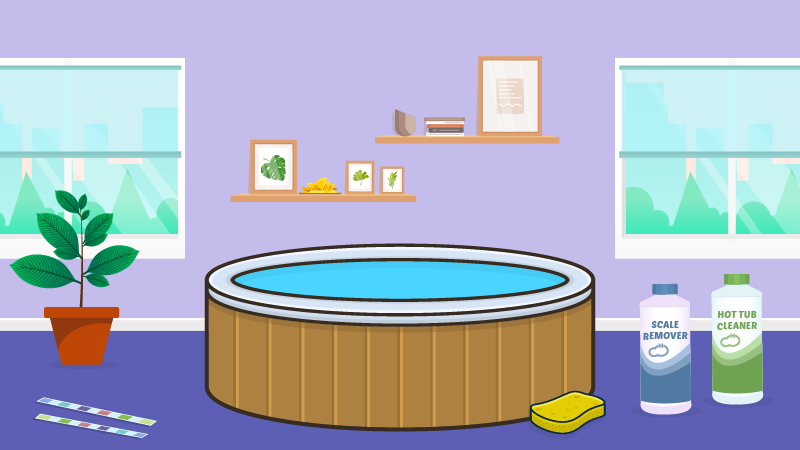Is Your Hot Tub Water Green? Here’s How to Solve That Now!
Is your hot tub water green? Green water in hot tubs is uncommon. But can be resolved quickly. It’s caused by either an algae bloom or a chemical reaction (specifically between copper and chlorine/bromine).
The best way to get rid of green water in your hot tub is to drain and refill it with fresh water. But suppose you want to solve the problem without doing that. In that case, you need to understand the causes and solutions to restoring your spa water clarity. Follow along with this article or watch our video for more information. 👇
Learn how to keep your hot tub clear while saving money so you can enjoy more soaking time without big costs. The Hot Tub Handbook covers every type of hot tub on earth.
The 2 Main Causes of Green Water in a Hot Tub
Your hot tub water turns green because of two main reasons: algae growth and metal presence, particularly copper. Let’s dive into these causes:
1. Algae Growth: The Primary Culprit
Green algae thrive in warm, unsanitized water. It can be introduced into your hot tub through:
- Contaminants from unwashed bathing suits previously used in lakes or oceans.
- Natural contaminants falling into the hot tub water.
Without adequate chlorine levels (or bromine levels), algae grows and turns the water green and slimy. It can also cause cloudy hot tub water and foaming issues.
Troubleshooting: You can troubleshoot an algae problem if the inside of your hot tub walls are slimy to the touch. If it’s not slimy (cloudy or foamy), you may have a metal problem.

2. Metal Presence: Copper’s Role
Copper mixed with chlorine or bromine can also turn your water green. This is similar to how the Statue of Liberty (which is made of 31 tons of copper) has turned green over time (this is 100% true).

The combination of copper and chlorine, just like copper and salt air (in the case of the statue), can lead to green discoloration.
But where does the copper come from? Copper can be introduced into the water though your city or well water with a garden hose. If you have copper in your tap water, you’ll want to use a hose filter when filling up your hot tub. In fact, I always recommend you do this with a new hot tub or when refilling your existing hot tub.
You can tell if you have this issue if the inside walls of the hot tub are not slimy and the water still looks clear.
Step-by-Step Guide to Clearing Green Water Caused by an Algae Growth
Assuming you’ve determined you have an algae problem (and you don’t want to just drain and refill your hot tub), here’s how to kill the algae.
1. Test the Water
First, test your hot tub water to ensure that the pH and alkalinity levels are balanced. Use a test strip or a liquid test kit. I recommend using a test strip because it’s cheap, fast, and easy. If you want more accuracy, use a liquid test kit (digital ones can be even more accurate).
Tests for 7 important chemistries in seconds: Total Hardness, Total Chlorine, Total Bromine, Free Chlorine, pH, Total Alkalinity, and Cyanuric Acid.
Your ideal pH levels should be between 7.4 and 7.6, and total alkalinity should be within 100-150 ppm (parts per million).
2. Adjust Your Hot Tub Chemicals (pH and Total Alkalinity)
If the pH and alkalinity are off-balance, use appropriate increasers or decreasers to adjust them. For example, use an Alkalinity Increaser (or baking soda) to raise both alkalinity and pH. Here’s more information on how to raise alkalinity in a hot tub.
Increase your hot tub total alkalinity with alkalinity increaser. Low alkalinity affects your pH and can stain and damage your hot tub surfaces and equipment.
If your pH and/or alkalinity are high, use a
Lower your hot tub pH with a pH decreaser. High pH can damage your hot tub equipment, cause cloudy water, and irritate eyes and skin.
3. Shock Your Hot Tub With Chlorine
Once balanced, shock the hot tub with an appropriate amount of chlorine shock treatment, even if you have a bromine hot tub. In case of heavy algae presence, double or triple the normal amount of shock. Here’s the shock we recommend.
A chlorine-based hot tub shock helps treat cloudy water, kill bacteria and algae, and remove contaminants after heavy hot tub usage. This formula also contains an oxidizer, which will help break apart any combined chlorine or bromine that's been used up in the water.
Note: Do not use a non-chlorine shock (a.k.a. oxidizer). You need a high dose of free chlorine to kill the algae. It might also be a good idea to remove your hot tub filters so they don’t get in the way of killing algae.
First, make sure your hot tub cover is off. Turn your jets on low and turn off your air valves. Also, use a nylon brush to scrape off any algae clinging to the inside of your hot tub. This will help the chlorine kill it.
If you don’t have chlorine shock, you can also add a double or triple dose of pure chlorine. The main goal is to kill the algae with chlorine.
Add the dose and let the chlorine do its job for at least 24 hours. Keep the cover off during this time so the chlorine can gas off.
What If You Have an Indoor Hot Tub or Swim Spa?
If you have an indoor hot tub, I recommend draining and refilling your hot tub with clean water. Here’s more information on how to empty and clean your hot tub.
How to Prevent Green Hot Tub Water
- Regular Testing: Test your water weekly using test strips. Make sure your hot tub chemical levels are within the correct ranges. This includes pH, alkalinity, calcium hardness, and chlorine levels (bromine too).
- Keep the Filtration System Running: Run your filter system as often as possible to keep the water clean and clear.
- Cover Your Hot Tub: Always cover your hot tub when not in use to prevent debris from entering the water.
- Clean Swimsuits: Wash and rinse swimsuits before using them in your hot tub to prevent algae introduction and detergent residue.
- Regular Water Care: Chlorinate or brominate your hot tub regularly, especially after heavy usage.
- Avoid Algaecides: Unless necessary, avoid using algaecides, especially copper-based ones, as they can contribute to green water issues.
- Consider a Mineral Sanitizer: Using a mineral sanitizer like Nature 2 can help maintain water clarity while using lower amounts of chlorine or bromine.
Reduce the amount of chlorine (0.5ppm) you use in your hot tub by adding this mineral sanitizer to your filter system and let the power of minerals sanitize your water.
Frequently Asked Questions About Green Hot Tub Water Problems
I sent an email asking hot tub owners if they’ve ever dealt with green hot tub water problems and if they had any questions. They did, and here are my answers to the most commonly asked questions.
Is it safe to go in green hot tub water?
It is not advisable to use a hot tub with green water. Green water can indicate algae growth or chemical imbalances, which may harbor harmful bacteria or irritants. It’s best to resolve the underlying issue and ensure the water is clear and chemically balanced before using the hot tub.
Why is my hot tub water green but chemicals balanced?
Even with balanced chemicals, hot tub water can turn green due to metals like copper in the water, possibly from source water or corroded equipment. The copper reacts with chlorine or other sanitizers, causing the green tint. A metal sequestrant or remover can help address this issue.
Will shocking a hot tub get rid of green water?
Shocking a hot tub can effectively get rid of green water, especially if the discoloration is due to algae. A high dose of chlorine shock breaks down the algae and restores water clarity. Ensure that the water chemistry is balanced after shocking.
Can too much bromine turn water green?
Excessive bromine itself does not typically turn hot tub water green. However, high bromine levels can react with metals like copper in the water, leading to a greenish tint. Regular testing and balancing of both sanitizer and metal levels can prevent this issue.
Can high alkalinity cause green water?
High alkalinity alone doesn’t usually cause green water but can contribute to conditions that favor algae growth or chemical imbalances. It’s essential to maintain alkalinity within the recommended range to support overall water balance and clarity.
3 Ways We Can Help With Your Hot Tub
- Hot Tub Cheat Sheets (Free): Easy-to-use guides to help you keep your hot tub water balanced and sanitized.
- The Hot Tub Handbook: An illustrated guide to DIY hot tub care, including water chemistry, maintenance, troubleshooting, and more.
- The Hot Tub Care Course. You’ll get step-by-step videos and a step-by-step downloadable guide with everything you need to know about hot tub maintenance.














